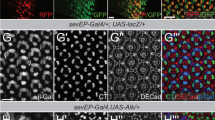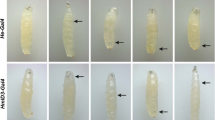Abstract
The human nm23–H1 gene is a suppressor of solid tumour metastasis in some types of cancer. It is known that nm23 genes encode nucleoside diphosphate kinase polypeptides, but the regulatory pathways involving Nm23 are unclear. One approach to understanding nm23 function is to identify loci which interact with nm23. The Drosophila awd gene, a homologue of nm23, provides a model system for this genetic analysis. We report that the dominant awdK–pn allele suppresses haematopoietic defects associated with the Tum–I oncogene. Premature differentiation and aggregation of Tum–I blood cells is reduced by awdK–pn, resulting in an increased survival of Tum–I hemizygotes. Tum–I lethality is also suppressed by pn mutations, indicating the existence of a haematopoietic regulatory pathway involving the Tum–I, AwdK–pn and Pn proteins.
This is a preview of subscription content, access via your institution
Access options
Subscribe to this journal
Receive 12 print issues and online access
$209.00 per year
only $17.42 per issue
Buy this article
- Purchase on Springer Link
- Instant access to full article PDF
Prices may be subject to local taxes which are calculated during checkout
Similar content being viewed by others
References
Liotta, L.A., Steeg, P.S. & Stetler-Stevenson, W.G. Cancer metastasis and angiogenesis: an imbalance of positive and negative regulation. Cell 64, 327–336 (1991).
Evans, C.W. A genetic basis for metastasis. Cell Biol. int. Rep. 15, 1175–1179 (1991).
Bevilaqua, G., Sobel, M.E., Liotta, L.A. & Steeg, P.A. Association of low nm23 RNA levels in human primary infiltrating ductal breast carcinomas with lymph node involvement and other histopathological indicators of high metastatic potential. Cancer Res. 49, 5185–5190 (1989).
Hennessy, C. et al. Expression of the anti-metastatic gene nm23 in human breast cancer; association with good prognosis. J. natn. Cancer Inst. 83, 281–285 (1991).
Steeg, P.S. et al. Evidence for a novel gene associated with low tumour metastatic potential. J. natn. Cancer Inst. 80, 200–204 (1988).
Steeg, P.S. et al. Altered gene expression in tumour metastasis: the nm23 gene. In Cancer Metastasis (eds Schirrmacher, V. & Schwartz-Albiez, R.) 48–52 (Springer, Heidelberg, 1989).
Steeg, P.S., Bevilacqua, G., Pozzatti, R., Liotta, L.A. & Sobel, M.E. Altered expression of nm23, a gene associated with low tumour metastatic potential, during adenovirus2 E1a inhibition of experimental metastasis. Cancer Res. 48, 6550–6554 (1988).
Okabe-Kado, J. et al. Identity of a differentiation inhibiting factor for mouse myeloid leukaemia cells with nm23/nucleoside diphosphate kinase. Biochem. Biophys. Res. Commun. 182, 987–994 (1992).
Keim, D. et al. Proliferation-related expression of p19/nm23 nucleoside diphosphate kinase. J. clin. Invest. 89, 919–924 (1992).
Stahl, J.A. et al. Identification of a second human nm23 gene, nm23-H2. Cancer Res. 51, 445–449 (1991).
Gilles, A.-M., Presecan, E., Vonica, A. & Lascu, I. Nucleoside diphosphate kinase from human erythrocytes. J. biol. Chem. 266, 8784–8789 (1991).
Parks, S., & Agarwal, R. Nucleoside diphosphokinase. In The Enzymes (ed. Boyer, P.D.) 307–344 (Academic, New York, 1973).
Dearolf, C.R., Tripoulas, N., Biggs, J. & Shearn, A. Molecular consequences of awdb3, a cell-autonomous lethal mutation of Drosophila induced by hybrid dysgenesis. Dev. Biol. 129, 169–178 (1988).
Wallet, V. et al. Dictyostelium nucleoside diphosphate kinase highly homologous to nm23 and awd proteins involved in mammalian tumour metastasis and development. J. natn. Cancer Inst. 18, 1199–1202 (1990).
Munoz-Dorada, J., Inouye, M. & Inouye, S. Nucleoside diphosphate kinase from Myxococcus xanthus. I. Cloning and sequencing of the gene. J. Biol. Chem. 265, 2702–2706 (1990).
Kimura, N., Shimada, N., Nomura, K. & Watanabe, K. Isolation and characterization of a cDNA clone encoding rat nucleoside diphosphate kinase. J. biol. Chem. 265, 15744–15749 (1990).
Nomura, T. et al. The amino acid sequence of nucleoside diphosphate kinase I from spinach leaves, as deduced from the cDNA sequence. Arch. Biochem. Biophys. 297, 42–45 (1992).
Dearolf, C.R., Hersperger, E. & Shearn, A. Developmental consequences of awdb3, a cell-autonomous lethal mutation of Drosophila induced by hybrid dysgenesis. Dev. Biol. 129, 159–168 (1988).
Rosengard, A.R. et al. Reduced nm23/awd protein in tumour metastasis and aberrant Drosophila development. Nature 342, 177–180 (1988).
Biggs, J., Tripoulas, N., Hersperger, E., Dearolf, C. & Shearn, A. Analysis of the lethal interaction between the prune and Killer of prune mutations of Drosophila. Genes Dev. 2, 1333–1343 (1988).
Sturtevant, A.H. A highly specific complementary lethal system in Drosophila melanogaster. Genetics 41, 118–123 (1956).
Corwin, H.O. & Hanratty, W.P. Characterization of a unique lethal tumourous mutation in Drosophila. Molec. gen. Genet. 14, 345–347 (1976).
Silvers, M. & Hanratty, W.P. Alterations in the production of haemocytes due to a neoplastic mutation of Drosophila melanogaster. J. Invert. Path. 44, 324–328 (1984).
Hanratty, W.P. & Ryerse, J.S. A genetic melanotic neoplasm of Drosophila melanogaster. Devl. Biol. 83, 238–249 (1981).
Perrimon, N. & Mahowald, A.P. I(1) hopscotch, a larval-pupal zygotic lethal with a specific maternal effect on segmentation in Drosophila. Devl. Biol. 118: 28–41 (1986).
Hanratty, W.P. & Dearolf, C.R., The Drosophila Tumourous-lethal haematopoietic oncogene is a dominant mutation in the hopscotch locus. Molec. gen. Genet. (in the press).
Wilks, A.F. et al. Two novel protein-tyrosine kinases, each with a second phosphotransferase-related catalytic domain, define a new class of protein kinase. Molec. cell. Biol. 11, 2057–2065 (1991).
Rizki, T.M. Alterations in the haemocyte population of Drosophila melanogaster. J. Morph. 100, 437–458 (1957).
Rizki, T.M. Experimental analysis of haemocyte morphology in insects. Am. Zool. 2, 247–256 (1962).
Sparrow, J.C. Melanotic tumours. In The Genetics and Biology of Drosophila, Vol 2B (eds Ashburner, M. & Wright, T.R.F.) 277–313 (Academic, New York, 1978).
Watson, K.L., Johnson, T.K. & Dennell, R.E. Lethal(1)aberrant immune response mutations leading to melanotic tumour formation in Drosophila melanogaster. Dev. Genet. 12, 173–187 (1991).
Hackstein, J.H.P. The lethal prune/Killer of prune interaction of Drosophila causes a syndrome resembling human neurofibromatosis (NF1). Eur. J. cell Biol. 58, 429–444 (1992).
Salt, G. The cellular defence reaction of insects. Cambridge Monogr. exp. Biol. Vol 16 (Cambridge University Press, Cambridge, 1970).
Bryant, P.J. & Sang, J.H. Physiological genetics of melanotic tumours in Drosophila melanogaster. VI. The tumourigenic effects of juvenile hormone-like substances. Genetics 62, 321–336 (1969).
Rizki, T.M. Tumour formation in relation to metamorphosis in Drosophila melanogaster. J. Morph. 100, 459–472 (1957).
Lascu, I., Chaffotte, A., Limbourg-Bouchon, B. & Veron, M. A pro/ser substitution in nucleoside diphosphate kinase of Drosophila melanogaster (mutation Killer of prune) affects stability but not catalytic efficiency of the enzyme. J. biol. Chem. 267, 12775–12781 (1992).
Teng, D.H.F., Engele, C.M. & Venkatesh, T.R. A product of the prune locus of Drosophila is similar to mammalian GTPase-activating protein. Nature 353, 437–440 (1991).
Evans, B.A. & Howells, A.J. Control of drosopterin synthesis in Drosophila melanogaster mutants showing an altered pattern of GTP cyclohydrolase activity during development. Biochem. Genet. 16, 13–26 (1978).
Mackey, W. & O'Donnell, J.M. A genetic analysis of the pteridine biosynthetic enzyme, guanosine triphosphate cyclohydrolase, in Drosophila melanogaster. Genetics 105, 35–53 (1983).
Barnes, T.M. & Burglin, T.R. Prune function? Nature 355, 504–505 (1992).
Lindsley, D.L. & Zimm, G.G. The Genome of Drosophila melanogaster. (Academic, San Diego, 1992).
Bodenstein, D. The postembryonic development of Drosophila. In Biology of Drosophila, (ed. Demerec, M.) 274–367 (Wiley, New York 1950).
Author information
Authors and Affiliations
Rights and permissions
About this article
Cite this article
Zinyk, D., McGonnigal, B. & Dearolf, C. Drosophila awdK–pn, a homologue of the metastasis suppressor gene nm23, suppresses the Tum–I haematopoietic oncogene. Nat Genet 4, 195–201 (1993). https://doi.org/10.1038/ng0693-195
Received:
Accepted:
Issue Date:
DOI: https://doi.org/10.1038/ng0693-195
This article is cited by
-
Double knockout Nme1/Nme2 mouse model suggests a critical role for NDP kinases in erythroid development
Molecular and Cellular Biochemistry (2009)
-
JAK signaling globally counteracts heterochromatic gene silencing
Nature Genetics (2006)



